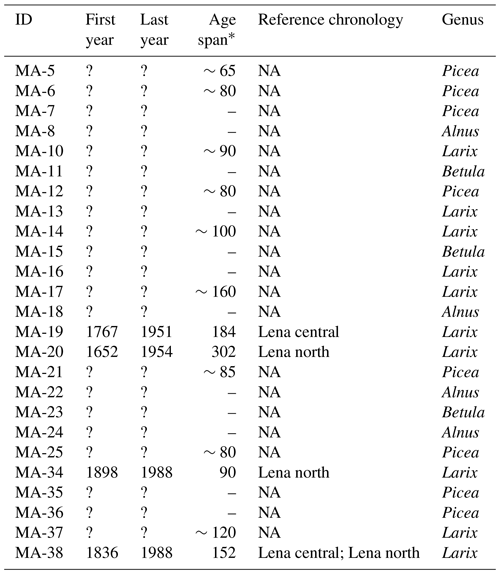the Creative Commons Attribution 4.0 License.
the Creative Commons Attribution 4.0 License.
Short communication: Driftwood provides reliable chronological markers in Arctic coastal deposits
Alexander Kirdyanov
Alan Crivellaro
Ulf Büntgen
Originating from the boreal forest and often transported over large distances, driftwood characterizes many Arctic coastlines. Here we present a combined assessment of radiocarbon (14C) and dendrochronological (ring width) age estimates of driftwood samples to constrain the progradation of two Holocene beach-ridge systems near the Lena Delta in the Siberian Arctic (Laptev Sea). Our data show that the 14C ages obtained on syndepositional driftwood from beach deposits yield surprisingly coherent chronologies for the coastal evolution of the field sites. The dendrochronological analysis of wood from modern drift lines revealed the origin and recent delivery of the wood from the Lena River catchment. This finding suggests that the duration of transport lies within the uncertainty of state-of-the-art 14C dating and thus substantiates the validity of age indication obtained from driftwood. This observation will help us better understand the response of similar coastal systems to past climate and sea-level changes.
- Article
(4135 KB) - Full-text XML
-
Supplement
(1904 KB) - BibTeX
- EndNote
The Arctic Ocean is strongly influenced by terrestrial runoff, and driftwood is a common feature in its coastal waters (Peterson et al., 2002; Yang et al., 2002; Woo and Thorne, 2003). Arctic driftwood mainly originates from the largest rivers in the boreal forests of Eurasia and North America, and trees are primarily mobilized by riverbank erosion during peak summer runoff (Gurnell et al., 2002; Costard et al., 2014; Kramer and Wohl, 2017). Studies in Arctic coastal and marine environments have used the presence, location, species, and age of driftwood to infer the long-term variability of ocean current dynamics, sea-ice conditions, and the occurrence of storm surges (e.g. Reimnitz and Maurer, 1979; Harper et al., 1988; Dyke et al., 1997; Tremblay et al., 1997; Bennike, 2004; Polyak et al., 2010; Nixon et al., 2016; Irrgang et al., 2019).
Age control on Holocene driftwood is commonly obtained by radiocarbon (14C) dating, and the reported uncalibrated ages may have uncertainties of the order of decades to centuries (e.g. Funder et al., 2011; Hole and Macias-Fauria, 2017). Modern radiocarbon facilities, however, can provide substantially lower methodological dating uncertainties (Wacker et al., 2010; Nixon et al., 2016; Mason et al., 2020; Fig. S1 in the Supplement). Radiocarbon-dated driftwood has also been used to indirectly infer the age of wave-built coastal deposits, alongside other organic materials, such as human artefacts, whale bones, and mollusc shells (e.g. Dyke et al., 1991; Forman et al., 1996, 2007; Funder et al., 2011). The advantage of using a terrestrial deposit for radiocarbon dating in a marine context is that reservoir corrections are not necessary. This is especially useful in brackish coastal environments in the proximity to major rivers and other sources of old carbon (Forman and Polyak, 1997; Dumond and Griffin, 2002; Grigoriev et al., 2004). Alternatively, well-preserved driftwood can be dated by cross-correlating tree-ring width measurements against independent, species-specific reference chronologies from the boreal catchments (Hellmann et al., 2013, 2017), often yielding an indication of the age of the outermost tree ring with a resolution of years to decades (Eggertson, 1994; Johansen, 1998; Steelandt et al., 2015).
Large unknown conceptual uncertainty lies in the pathway and duration of wood transport in the riverine and marine environments prior to deposition in a coastal system. Wood transport in rivers is not particularly well-investigated and depends largely on catchment properties and runoff regime (Kramer and Wohl, 2017; Kramer et al., 2017). The few studies available suggest that residence times in watersheds are of the order of several years to centuries, with large uncertainties in the fate of the wood following recruitment (Swanson and Lienkaemper, 1978; Schenk et al., 2014; Alix, 2016). Once the driftwood has reached the ocean, it is often argued that sea-ice-bound transport across the Arctic occurs within a few years and that free-floating wood sinks over a matter of months (Häggblom, 1982; Dyke et al., 1997; Bennike, 2004; Funder et al., 2011). A relatively rapid dispersal of driftwood is likewise supported by the results of Hellmann et al. (2016a), who studied logging debris from the coasts of Svalbard, Greenland, and Iceland by dendrochronological means. The authors showed that the age of the logs correlates well with a historically documented period of intensive forest use in Siberia in the mid-20th century.
Here, we evaluate the reliability of age estimates from driftwood in an Arctic coastal environment near a large forested source area by combining the 14C dating of buried Holocene wood from prograded beach deposits with the dendrochronological cross-dating of modern driftwood samples from the same coastal site. Obtaining reliable age control with a sufficiently high resolution is crucial to identify small changes in the long-term rates of past coastal evolution in relation to the external effects of climate, sea level, or storm surges.
2.1 Research area
Driftwood samples from two field sites along the south-western seaboard of Buor Khaya Bay (Laptev Sea, Republic of Sakha, Russian Federation) are investigated. The northern site is referred to as Bys Tasa (BY; 71∘2′ N; 130∘11′ E) and the southern site as Makhchar (MA; 70∘59′ N, 130∘14′ E). Due to the proximity to the Lena Delta (Büntgen et al., 2014), the brackish surface water in Buor Khaya Bay during the ice-free summer months contains large quantities of driftwood (Pavlov et al., 1996; Günther et al., 2011). The area is microtidal (tidal range: ∼0.4 m), but water levels are subject to considerable wind-forced variation with surge heights of up to 2.5 m above mean sea level (Ashik and Vanda, 1995; Pavlov et al., 1996; Lantuit et al., 2012). BY and MA are comprised of wide sets of coarse-clastic beach ridges that separate coastal lagoons from the open water of the bay. Beach ridges form at locations along wave-dominated shorelines, where accommodation and sediment supply have been positive over extensive periods of time. Prograded beach-ridge systems and spits are recurrent features along the shoreline of the eastern Laptev Sea, but they remain largely unstudied (with the exception of Sander et al., 2019). In most cases, each visible ridge is a time-integrated feature formed during multiple periods of reworking rather than during an individual event (Tamura, 2012; Lindhorst and Schutter, 2014). At the two studied field sites, driftwood is present as syndepositional debris within the beach deposits, at different elevations on the modern beach surface, and as overtopped debris (Fig. 1, top right).
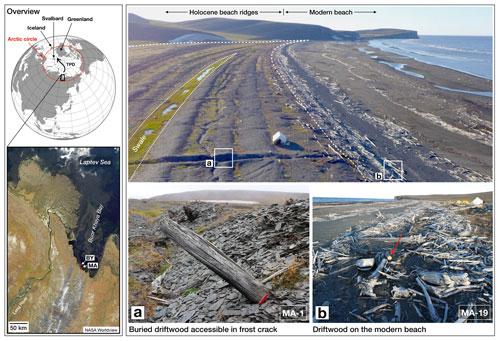
Figure 1Left: overview sketch of the location of the research area. Top right: aerial view of the Makhchar field site showing the location of the Holocene beach ridges and the modern beach, with the distribution of wood arranged in drift lines from high-, medium-, and low-energy situations. Bottom right: (a) buried Holocene driftwood accessible in a frost crack and (b) a dense assemblage of driftwood on the modern beach face (code indicates sample ID; see Table 2).
2.2 Sampling design
A total of 28 driftwood samples were taken for radiocarbon dating to establish age control on the beach-ridge sequences at BY and MA. The driftwood was accessible in frost cracks and in areas of intensive cryoturbation (Fig. 1a). Where possible, multiple samples of distinct driftwood were collected from each location (here referred to as sets; Tables 1 and 2). The wood was stabilized in situ with string and duct tape to prevent disintegration. Collected with a manually operated saw, the samples were stored in the field under well-aerated conditions and later cleaned in the laboratory and dried for at least 48 h at 45 ∘C. For stem discs, subsamples for 14C dating were taken from the outermost preserved tree rings and submitted to the MICADAS radiocarbon dating laboratory of the Alfred Wegener Institute in Bremerhaven, Germany. A description of the sample preparation and dating protocol can be found in Sander et al. (2019). The obtained 14C ages were calibrated using OxCal 4.3 (Bronk Ramsey, 2009) and the IntCal13 calibration curve (Reimer et al., 2013). All ages are reported in the BCE–CE system to allow a better comparison with the modern driftwood data. For the two beach-ridge systems, Bayesian age–distance models (P sequences; Figs. S2 and S3) were constructed in OxCal 4.3 using the distance of each sample from the innermost preserved beach ridge as a spatial and chronological reference (Bronk Ramsey, 2008; Sander et al., 2019).
Table 1Overview of radiocarbon samples from Bys Tasa (BY).
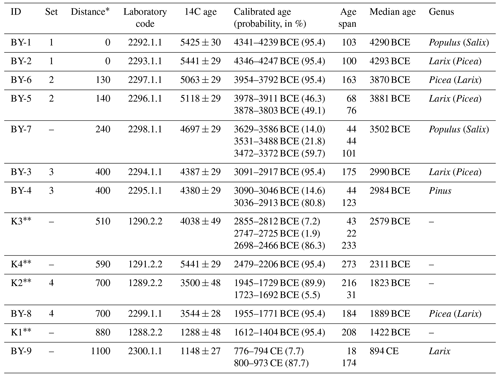
* Distance from the innermost beach ridge in metres. Sampled in 2017.
Table 2Overview of radiocarbon samples from Makhchar (MA).
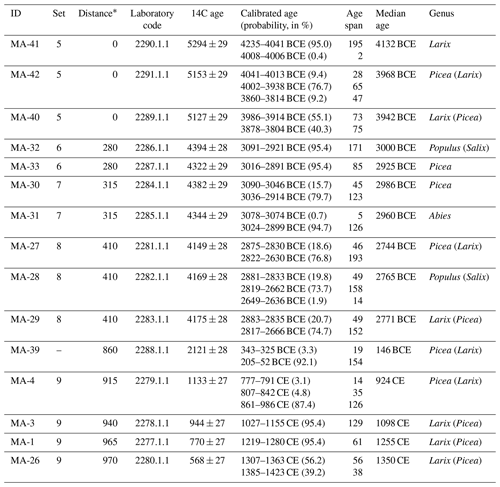
* Distance from the innermost beach ridge in metres.
At MA, 26 stem discs were taken from driftwood along the modern beach for dendrochronological age determination and wood anatomical species identification. The analyses were conducted at the Tree-Ring Unit at the Department of Geography, University of Cambridge, UK. The surface of the discs was polished with sandpaper of progressively fine grain size to 600 grid, and tree-ring widths of all samples were measured on a Velmex tree-ring measuring system with a resolution of 0.001 mm (Velmex Inc., Bloomfield, NY, USA). The individual series were cross-dated against regional reference chronologies from northern Yakutia (Hellmann et al., 2016b) using TSAP-win (Rinntech, Heidelberg, Germany) and COFECHA (Version 6.02P). Wood anatomical sections were cut with a razor blade from transverse, radial, and tangential sections, mounted with water between two cover glasses, and analysed using an Olympus CX22LED microscope at 20–400× magnification. Based on wood macroscopic (Ruffinatto and Crivellaro, 2019) and anatomical (Wheeler et al., 1989; Richter et al., 2004) features, each sample was identified to the species or closest possible taxon level using reference identification keys (Benkova and Schweingruber, 2004).
3.1 Holocene driftwood
The 13 samples from BY yielded ages between 4300 BCE and 900 CE, and the 15 samples from MA exhibited ages between 4100 BCE and 1400 CE. These dates establish a robust middle to late Holocene formation of the two beach-ridge systems. The four sets sampled at BY yielded uncalibrated 14C ages with overlapping uncertainties, hence resulting in very similar calibrated age ranges (Fig. 2a; Table 1, sets 1–4). The analysis of wood anatomy for the densely spaced sets revealed that different genera were dated and ruled out the possibility that parts of the same tree were accidentally sampled (Table 1). At MA, a set was sampled on the innermost and hence oldest preserved beach ridge (set 5, n=3, Table 2). Two of the three samples have very similar median ages (3940 BCE, MA-40; 3970 BCE, MA-42), while one sample is ∼200 years older (4130 BCE, MA-41), and the calibrated probabilities (2σ) do not overlap (Fig. 2b). In the lateral part of the beach-ridge system, the ages of three sets, located at cross-ridge distances of 35 and 95 m, were determined (sets 6–8). Similar to BY, the age control within each set is coherent, but the ages of the more closely spaced sets overlap entirely. However, since both sets are located on either side of the same swale (a morphological depression between beach ridges; see Fig. 2), it is not unlikely that both sets, despite their slight spatial offset, originate from the same depositional event (or series of events). All median ages of the two sets lie within a window of 75 years. The 14C ages of the third set (set 8, n=3) from the lateral part of MA overlap entirely. They have the same age within the uncertainty of the method but do not overlap with sets 6–7 (Fig. 2c). Four samples were taken as a series across two distinct beach ridges in the outermost part of MA. The distance between the innermost and the outermost sample is ∼50 m. Despite the proximity of the samples, there is no overlap between the 2σ age ranges and no age inversions (Fig. 2d, Table 2). The wood anatomical assessment of the MA material confirms that different genera were dated within closely spaced sets.
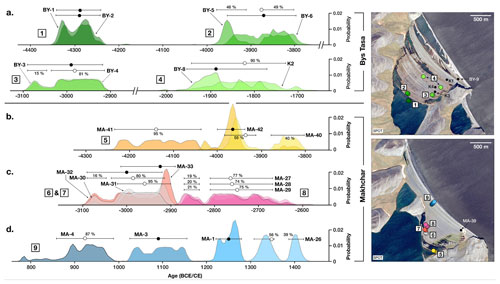
Figure 2Comparison of the calibrated radiocarbon probabilities between the sample sets obtained from the field sites. Two sigma age ranges (95.4 %) are indicated by the horizontal bar, and the location of the circle indicates the median age of the sample. Empty circles indicate probabilities <95.4 %, and the values are given above the respective bar. Probabilities <10 % are not displayed. The figure illustrates that most of the age indications obtained from samples at stratigraphically similar positions overlap almost entirely (a, b, c), and that sensitive changes in coastal progradation can be captured by closely spaced samples (d). Background image SPOT7; ©Airbus DS 2017.
The driftwood 14C ages are incorporated into Bayesian age models for beach-ridge progradation (Fig. 3). The rationale behind this is that beach ridges are aligned to the angle of approach of wave energy during formative events. This determines that the innermost beach ridge is oldest, and that the age of each beach ridge is the same along its entire length within the time necessary for beach-ridge formation. This age–distance relationship is assumed to be most pronounced in rapidly prograding systems characterized by continuous sediment and energy supply, as well as deposition within a protected environment, hence minimizing reworking or erosion.
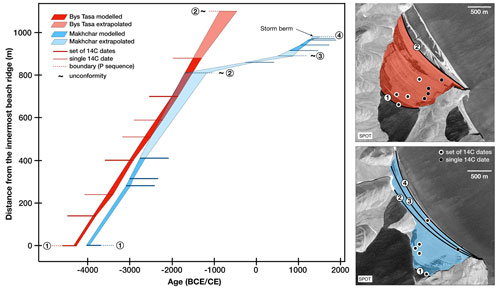
Figure 3Age–distance models for the progradation of the two beach-ridge systems. Solid lines mark the position of samples and sample sets. The circled numbers on the right indicate the location of boundaries in the P sequence as the first and last preserved ridges and unconformities in the pattern of progradation. The black circles indicate the location of individual samples and sample sets (see Fig. 2 and Tables 1 and 2 for further details). Background data: SPOT7; ©Airbus DS 2017.
A comparison of the age models from the two field sites shows a high degree of coherence in the timing and rate of coastal evolution. Both BY and MA initiated around 4000 BCE and prograded over the mid-Holocene at a rate of 0.3 m yr−1. Deposition at BY ceased at around 400 BCE, while MA entered a period of slow or punctuated progradation between 1500 BCE and 700 CE, before experiencing renewed progradation between 700 CE and 1400 CE. No beach sediment is preserved at MA after that time. At BY, the mode of beach-ridge progradation changed after 400 BCE and appears to have become limited by sediment supply or a limitation in transport capacity (Sander et al., 2019). A single sample (BY-9) from the outer beach ridges is coherent with the period of renewed progradation at MA. The timing of changes in coastal evolution fits reasonably well with studies proposing the existence of periods of warmer climate conditions in the wider Laptev Sea area during the middle and late Holocene (Andreev and Klimanov, 2000; Andreev et al., 2011). However, the current understanding of the timing and magnitude of past climate variability in Siberia remains inconclusive (Büntgen et al., 2014). Furthermore, there is significant offset in previous findings (see Biskaborn et al., 2016, for a review). Our data suggest that prograded coastal systems may provide viable candidates to study the effective importance of variability in wave–climate interaction as a function of reduced or increased fetch resulting from past changes in the extent and duration of sea-ice cover.
3.2 Modern driftwood
Four Larix samples from the drift lines of MA were dendro dated and provenanced (Table 3). The youngest tree rings in two samples have calendar ages of 1951 CE and 1954 CE (MA-19, MA-20). The outer rings in two other samples were dated to 1988 CE (MA-34, MA-38). The relatively recent ages of wood samples on the modern beach of Buor Khaya Bay suggest that the driftwood passed its “life cycle” from erosion to transport and deposition within the last 30 and 70 years, respectively. This agrees with Kramer and Wohl (2017), who propose that the transfer of wood in large rivers (watersheds >106 km2) can be rapid. This means in practical terms that the uncertainties associated with the unassessed transport pathways of driftwood through the Lena catchment are lower than the methodological uncertainties associated with state-of-the-art 14C dating (Fig. S1). In our case, the tree rings in the modern samples contain up to ∼300 years, which illustrates that considerable offsets in the indicative value of the 14C age determination will occur if the position of a 14C sample is unknown within the tree-ring sequence. Furthermore, driftwood may be subject to abrasion during transport or decay after deposition from exposure to e.g. humidity and biological activity (Fig. S4). The age of most samples (n=21) could not be determined, as the age span of the samples was too short for reliable cross-dating against boreal reference chronologies from north-eastern Siberia (Table 3). However, the emerging possibilities of high-resolution 14C measurements (Brehm et al., 2021) offer a way to trace the atmospheric 14C bomb peak of the 1960s (Levin and Hesshaimer 2000; Andreu-Hayles et al., 2015), and cosmic events (Büntgen et al., 2018) thus represent an additional tool to support the dendro-dating of driftwood.
By comparing 14C dates from buried driftwood with dendrochronological estimates of the age of modern drift lines in an Arctic coastal setting of eastern Siberia, this study shows that reliable age indication for Holocene coastal change can be obtained from syndepositional driftwood. Conceptual age uncertainties associated with the river-borne transport of the wood appear to be insignificant for large river systems, such as the Lena. The radiocarbon dating of driftwood has been widely used in a range of coastal settings across the Arctic, but chronologies have never before been systematically compared with the precise (dendrochronological) age of modern driftwood. The possibility to determine the age of driftwood with annual precision may provide an ideal proxy for the study of driftwood delivery by low-frequency events (e.g. coastal storm surges). Reliable and precise chronological data are crucial for understanding the mesoscale response of fragile coastal systems to the effects of past climate variability and sea-level changes.
All data supporting the findings of this study are available within the article and the Supplement.
The supplement related to this article is available online at: https://doi.org/10.5194/gchron-3-171-2021-supplement.
LS and UB designed the study, LS conducted the field sampling, and AK and AC carried out the analyses of the wood samples. LS prepared the paper with substantial contribution from all authors.
The authors declare that they have no conflict of interest.
We acknowledge the use of Terra/MODIS imagery distributed through the NASA Worldview platform (https://worldview.earthdata.nasa.gov, last access: 7 September 2020), part of the NASA Earth Observing System Data and Information System (EOSDIS). Toru Tamura and Anthony Jull are thanked for providing valuable comments on an earlier version of this paper.
This study received funding from the Coastal Ecology section of the Alfred Wegener Institute, Helmholtz Centre for Polar and Marine Research. Alan Crivellaro received funding from the Fritz and Elisabeth Schweingruber Foundation. Ulf Büntgen received funding from SustES – Adaptation strategies for sustainable ecosystem services and food security under adverse environmental conditions (grant no. CZ.02.1.01/0.0/0.0/16_019/0000797), as well as from the ERC project MONOSTAR (grant no. AdG 882727).
This paper was edited by Irka Hajdas and reviewed by Toru Tamura and Anthony Jull.
Alix, C.: A critical resource: wood use and technology in the North American Arctic, in: The Oxford handbook of the prehistoric Arctic, edited by: Friesen, T. M. and Mason, O. K., Oxford, Oxford University Press, 109–130, 2016.
Andreev, A. A. and Klimanov, V. A.: Quantitative Holocene climatic reconstruction from Arctic Russia, J. Paleolimnol., 24, 81–91, https://doi.org/10.1023/A:1008121917521, 2000.
Andreev, A. A., Schirrmeister, L., Tarasov, P. E., Ganopolski, A., Brovkin, V., Siegert, C., Wetterich, S., and Hubberten, H.-W.: Vegetation and climate history in the Laptev Sea region (Arctic Siberia) during Late Quaternary inferred from pollen records, Quaternary Sci. Rev., 30, 2182–2199, https://doi.org/10.1016/j.quascirev.2010.12.026, 2011.
Andreu-Hayles, L., Santos, G. M., Herrera-Ramírez, D. A., Martin-Fernández, J., Ruiz-Carrascal, D., Boza-Espinoza, T. E., Fuentes, A. F., and Jørgensen, P. M., Matching dendrochronological dates with the Southern Hemisphere 14C bomb curve to confirm annual tree rings in Pseudolmedia rigida from Bolivia, Radiocarbon, 57, 1–13, https://doi.org/10.2458/azu_rc.57.18192, 2015.
Ashik, I. M. and Vanda, Y. A.: Catastrophic storm surges in the southern part of the Laptev Sea, in: Russian-German Cooperation: Laptev Sea System, edited by: Kassens, H., Piepenburg, D., Tiede, J., Timokhov, L., Hubberten, H.-W., and Priamikov, S. M., Rep. Pol. Res., 176, 43–46, https://doi.org/10.2312/BzP_0176_1995, 1995.
Benkova, V. E. and Schweingruber, F. H.: Anatomy of Russian woods, Haupt, Bern, 456 pp., 2004.
Bennike, O.: Holocene sea-ice variations in Greenland: onshore evidence, Holocene, 14, 607–613, https://doi.org/10.1191/0959683604hl722rr, 2004.
Biskaborn, B. K., Subetto, D., Savelieva, L. A., Vakhrameeva, P. S., Hansche, A., Herzschuh, U., Klemm, J., Heinecke, L., Pestryakova, L., Meyer, H., Kuhn, G., and Diekmann, B.: Late Quaternary vegetation and lake system dynamics in north-eastern Siberia: Implications for seasonal climate variability, Quaternary Sci. Rev., 147, 406–421, https://doi.org/10.1016/j.quascirev.2015.08.014, 2016.
Brehm, N., Bayliss, A., Christl, M., Synal, H.-A., Adolphi, F., Beer, J., Kromer, B., Muscheler, R., Solanki, S. K., Usoskin, I., Bleicher, N., Bollhalder, S., Tyers, C., and Wacker, L.: Eleven-year solar cycles over the last millennium revealed by radiocarbon in tree rings, Nat. Geosci., 14, 10–15, https://doi.org/10.1038/s41561-020-00674-0, 2021.
Bronk Ramsey, C.: Deposition models for chronological records, Quaternary Sci. Rev., 27, 42–60, https://doi.org/10.1016/j.quascirev.2007.01.019, 2008.
Bronk Ramsey, C.: Bayesian analysis of radiocarbon dates, Radiocarbon, 51, 337–360, https://doi.org/10.1017/S0033822200033865, 2009.
Büntgen, U., Kirdyanov, A. V., Hellmann, L., Nikolayev, A., and Tegel W.: Cruising an archive: on the palaeoclimatic value of the Lena Delta, Holocene, 24, 627–630, https://doi.org/10.1177/0959683614523805, 2014.
Büntgen, U., Wacker, L., Galván, J. D., Arnold, S., Arseneault, D., Baillie, D., Beer, J., Bernabei, M., Bleicher, N., Boswijk, G., Bräuning, A., Career, M., Charpentier Ljungqvist, F., Cherubini, P., Christl, M., Christie, D. A., Clark, P. W., Cook, E. R., D'Arrigo, R., Davi, N., Eggertsson, Ó., Esper, J., Fowler, A. M., Gedalof, Z., Gennaretti, F., Grießinger, J., Grissino-Mayer, H., Grudd, H., Gunnarson, B.E., Hantemirov, R., Herzig, F., Hessl, A., Heussner, K.-U., Jull, A. J. T., Kirdyanov, A., Kolář, T., Krusic, P. J., Kyncl, T., Lara, A., LeQuesne, C., Linderholm, H. W., Loader, N., Luckman, B., Miyake, F., Myglan, V., Nicolussi, K., Oppenheimer, C., Palmer, J., Panyushkina, I., Pederson, N., Rybníček, M., Schweingruber, F. H., Seim, A., Sigl, M., Churakova (Sidorova), O., Speer, J. H., Synal, H.-A., Tegel, W., Treydte, K., Villalba, R., Wiles, G., Wilson, R., Winship, L. J., Wunder, J., Yang, B., and Young, B.: Tree rings reveal globally coherent signature of cosmogenic radiocarbon events in 774 and 993 CE, Nat. Commun., 9, 3605, https://doi.org/10.1038/s41467-018-06036-0, 2018.
Costard, F., Gautier, E., Fedorov, A., Konstantinov, P., and Dupeyrat, L.: An assessment of the erosion potential of the fluvial thermal process during ice breakups of the Lena River (Siberia), Permafrost Periglac., 25, 162–171, https://doi.org/10.1002/ppp.1812, 2014.
Dumond, D. E. and Griffin, D. G.: Measurements of the Marine Reservoir Effect on Radiocarbon Ages in the Eastern Bering Sea, Arctic, 55, 77–86, https://doi.org/10.14430/arctic692, 2002.
Dyke, A. S., Morris, T. F., and Green, D. E. C.: Postglacial tectonic and sea level history of the central Canadian Arctic, Geol. Surv. Can. Bull., 397, 56 pp., https://doi.org/10.4095/132168, 1991.
Dyke, A. S., England, J., Reimnitz, E., and Jetté, H.: Changes in driftwood delivery to the Canadian Arctic Archipelago: the hypothesis of postglacial oscillations of the Transpolar Drift, Arctic, 50, 1–16, https://doi.org/10.14430/arctic1086, 1997.
Eggertsson, Ó.: Mackenzie River driftwood – A dendrochronological study, Arctic, 47, 128–136, https://doi.org/10.14430/arctic1282, 1994.
Forman, S. L., Lubinski, D., Miller, G. H., Matishov, G. G., Korsun, S., Snyder, J., Herlihy, F., Weihe, R., and Myslivets, V.: Postglacial emergence of western Franz Josef Land, Russia, and retreat of the Barents Sea Ice sheet, Quaternary Sci. Rev., 15, 77–90, https://doi.org/10.1016/0277-3791(95)00090-9, 1996.
Forman, S. L., Weihe, R., Lubinski, D., Tarasov, G., Korsun, S., and Matishov, G.: Holocene relative sea-level history of Franz Josef Land, Russia, Geol. Soc. Am. Bull., 109, 1116–1133, https://doi.org/10.1130/0016-7606(1997)109< 1116:HRSLHO>2.3.CO;2, 2007.
Forman, S. L. and Polyak, L.: Radiocarbon content of pre-bomb marine mollusks and variations in the reservoir age for coastal areas of the Barents and Kara Seas, Russia, Geophys. Res. Lett., 24, 885–888, https://doi.org/10.1029/97GL00761, 1997.
Funder, S., Goosse, H., Jepsen, H., Kaas, E., Kjær, K. H., Korsgaard, N. J., Larsen, N. K., Linderson, H., Lyså, A., Möller, P., Olsen, J., and Willerslev, E.: A 10,000-year record of Arctic Ocean sea-ice variability – A view from the beach, Science, 333, 747–750, https://doi.org/10.1126/science.1202760, 2011.
Günther, F., Overduin, P. P., and Sandakov A.: Topographical surveys for coastal dynamics studies, in: Russian-German Cooperation: System Laptev Sea, The expedition Eastern Laptev Sea-Buor Khaya Peninsula 2010, edited by: Wetterich, S., Overduin, P. P., and Grigoriev, M., Rep. Pol. Mar. Res., 629, 94 pp., https://doi.org/10.2312/BzPM_0629_2011, 2011.
Grigoriev, M. N., Rachold, V., Schirrmeister, L., and Hubberten, H. W.: Organic carbon input to the Arctic Seas through coastal erosion, in: The organic carbon cycle in the Arctic Ocean, edited by: Stein, R. and Macdonald, R. W., Berlin, Springer, 41–45, 2004.
Gurnell, A. M., Piégay, H., Swanson, F. J., and Gregory, S. V.: Large wood and fluvial processes, Freshwater Biol., 47, 601–619, https://doi.org/10.1046/j.1365-2427.2002.00916.x, 2002.
Häggblom, A.: Driftwood in Svalbard as an indicator of sea ice conditions: a preliminary report, Geogr. Ann. A., 64, 81–94, https://doi.org/10.1080/04353676.1982.11880057, 1982.
Harper, J. R., Henry, R. F., and Stewart, G. G.: Maximum storm surge elevations in the Tuktoyaktuk region of the Canadian Beaufort Sea, Arctic, 41, 48–52, https://doi.org/10.14430/arctic1691, 1988.
Hellmann, L., Tegel, W., Eggertsson, Ó., Schweingruber, F. H., Blanchette, R., Kirdyanov, A., Gärtner, H., and Büntgen, U.: Tracing the origin of Arctic driftwood, J. Geophys. Res.-Biogeo., 118, 68–76, https://doi.org/10.1002/jgrg.20022, 2013.
Hellmann, L., Kirdyanov, A., and Büntgen, U.: Effects of boreal timber rafting on the composition of arctic driftwood, Forests, 7, 257, https://doi.org/10.3390/f7110257, 2016a.
Hellmann, L., Agafonov, L., Churakova (Sidorova), O., Düthorn, E., Eggertsson, Ó., Esper, J., Kirdyanov, A. V., Knorre, A. A., Moiseev, P., Myglan, V. S., Nikolaev, A. N., Reinig, F., Schweingruber, F., Solomina, O., Tegel, W., and Büntgen, U.: Regional coherency of boreal forest growth defines Arctic driftwood provenancing, Dendrochronologia, 39, 3–9, https://doi.org/10.1016/j.dendro.2015.12.010, 2016b.
Hellmann, L., Tegel, W., Geyer, J., Kirdyanov, A. V., Nikolaev, A. N., Eggertsson, Ó, Altman, J., Reinig, F., Morganti, S., and Büntgen, U.: Dendro-provenancing of Arctic driftwood, Quaternary Sci. Rev., 162, 1–11, https://doi.org/10.1016/j.quascirev.2017.02.025, 2017.
Hole, G. M. and Macias-Fauria, M.: Out of the woods: Driftwood insights into Holocene pan-Arctic sea ice dynamics, J. Geophys. Res.-Oceans, 122, 7612–7629, https://doi.org/10.1002/2017JC013126, 2017.
Irrgang, A. M., Lantuit, H., Gordon, R. R., Piskor, A., and Manson, G. K.: Impacts of past and future coastal changes on the Yukon coast – Threats for cultural sites, infrastructure, and travel routes, Arctic Sci., 5, 107–126, https://doi.org/10.1139/as-2017-0041, 2019.
Johansen, S.: The origin and age of driftwood on Jan Mayen, Polar Res., 17, 125–146, https://doi.org/10.1111/j.1751-8369.1998.tb00267.x, 1998.
Kramer, N., Wohl E., Hess-Homeier, B., and Leisz, S.: The pulse of driftwood export from a very large forested river basin over multiple time scales, Slave River, Canada, Water Resour. Res., 53, 1928–1947, https://doi.org/10.1002/2016WR019260, 2017.
Kramer, N. and Wohl, E.: Rules of the road: A qualitative and quantitative synthesis of large wood transport through drainage networks, Geomorphology, 279, 74–97, https://doi.org/10.1016/j.geomorph.2016.08.026, 2017.
Lantuit, H., Overduin, P. P., Couture, N., Wetterich, S., Aré, F., Atkinson, D., Brown, J., Cherkashov, G., Drozdov, D., Forbes, D. L., Graves-Gaylord, A., Grigoriev, M., Hubberten, H. W., Jordan, J., Jorgenson, T., Ødegård, R. S., Ogorodov, S., Pollard, W. H., Rachold, V., Sedenko, S., Solomon, S., Steenhuisen, F., Streletskaya, I., and Vasiliev, A.: The Arctic coastal dynamics database: a new classification scheme and statistics on Arctic permafrost coastlines, Estuar. Coast., 35, 383–400, https://doi.org/10.1007/s12237-010-9362-6, 2012.
Levin, I. and Hesshaimer, V.: Radiocarbon – A unique tracer of global carbon cycle dynamics, Radiocarbon, 42, 69–80, https://doi.org/10.1017/S0033822200053066, 2000.
Lindhorst, S. and Schutter, I.: Polar gravel beach-ridge systems: Sedimentary architecture, genesis, and implications for climate reconstructions (South Shetland Islands/Western Antarctic Peninsula), Geomorphology, 221, 187–203, https://doi.org/10.1016/j.geomorph.2014.06.013, 2014.
Mason, O. K., Jensen, A. M., Rinck, B., Alix, C. M., Bowers, P. M., and Hoffecker, J. F.: Heightened early medieval storminess across the Chukchi Sea, AD 400–1100: A proxy of the Late Antique Little Ice Age, Quatern. Int., 549, 98–117, https://doi.org/10.1016/j.quaint.2019.01.042, 2020.
Nixon, F. C., England, J. H., Lajeunesse, P., and Hanson, M. A.: An 11 000-year record of driftwood delivery to the western Queen Elizabeth Islands, Arctic Canada, Boreas, 45, 494–507, https://doi.org/10.1111/bor.12165, 2016.
Pavlov, V. K., Timonov, L. A., Baskakov, G. A., Kulakov, M. Y., Kurazhov, V. K., Pavlov, P. V., Pivovarov, S. V., and Stanovoy, V. V.: Hydrometeorological regime of the Kara, Laptev and East-Siberian seas, Technical Memorandum APL-UW TM 1-96, Applied Physics Laboratory, University of Washington, 179 pp., 1996.
Peterson, B. J., Holmes, R. M., McClelland, J. W., Vörösmarty, C. J., Lammers, R. B., Shiklomanov, A. I., Shiklomanov, I. A., and Rahmstorf, S.: Increasing River Discharge to the Arctic Ocean, Science, 298, 2171–2173, https://doi.org/10.1126/science.1077445, 2002.
Polyak, L., Alley, R. B., Andrews, J. T., Brigham-Grette, J., Cronin, T. M., Darby, D. A., Dyke, A. S., Fitzpatrick, J. J., Funder, S., Holland, M., Jennings, A. E., Miller, G. H., O'Regan, M., Savelle, J., Serreze, M., St. John, K, White, J. W. C., and Wolff, E.: History of sea ice in the Arctic, Quaternary Sci. Rev., 29, 1757–1778, https://doi.org/10.1016/j.quascirev.2010.02.010, 2010.
Reimer, P. J., Bard, E., Bayliss, A., Beck, J. W., Blackwell, P. G., Bronk Ramsey, C., Grootes, P. M., Guilderson, T. P., Haflidason, H., Hajdas, I., Hattz, C., Heaton, T. J., Hoffmann, D. L., Hogg, A. G., Hughen, K. A., Kaiser, K. F., Kromer, B., Manning, S. W., Niu, M., Reimer, R. W., Richards, D. A., Scott, E. M., Southon, J. R., Staff, R. A., Turney, C. S. M., and van der Plicht, J.: IntCal13 and Marine13 Radiocarbon Age Calibration Curves 0-50,000 Years cal BP, Radiocarbon, 55, 1869–1887, https://doi.org/10.2458/azu_js_rc.55.16947, 2013.
Reimnitz, E. and Maurer, D. K.: Effects of Storm Surges on the Beaufort Sea Coast, Northern Alaska, Arctic, 32, 329–344, https://doi.org/10.14430/arctic2631, 1979.
Richter, H. G., Grosser, D., Heinz, I., and Gasson, P. E.: IAWA list of microscopic features for softwood identification, Iawa J., 25, 1–70, 2004.
Ruffinatto, F. and Crivellaro, A.: Atlas of Macroscopic Wood Identification: With a Special Focus on Timbers Used in Europe and CITES-listed Species, Springer Nature, Cham, Switzerland, 439 pp., 2019.
Sander, L., Michaelis, R., Papenmeier, S., Pravkin, S., Mollenhauer, G., Grotheer, H., Gentz, T., and Wiltshire, K. H.: Indication of Holocene sea-level stability in the southern Laptev Sea recorded by beach ridges in north-east Siberia, Russia, Polar Res., 38, 3379, https://doi.org/10.33265/polar.v38.3379, 2019.
Schenk, E. R., Moulin, B., Hupp, C. R., and Richter, J. M.: Large wood budget and transport dynamics on a large river using radio telemetry, Earth Surf. Proc. Land., 39, 487–498, https://doi.org/10.1002/esp.3463, 2014.
Steelandt, S., Marguerie, D., Bhiry, N., and Delwaide, A.: A study of the composition, characteristics, and origin of modern driftwood on the western coast of Nunavik (Quebec, Canada), J. Geophys. Res.-Biogeo., 120, 480–501, https://doi.org/10.1002/2014JG002731, 2015.
Swanson, F. J. and Lienkaemper, G. W.: Physical Consequences of Large Organic Debris in Pacific-Northwest Streams, Gen. Tech. Rep. PNW-69, USDA Forest Service, Portland, Oregon, 12 pp., 1978.
Tamura, T.: Beach ridges and prograded beach deposits as palaeoenvironment records, Earth Sci. Rev., 114, 279–297, https://doi.org/10.1016/j.earscirev.2012.06.004, 2012.
Tremblay, L. B., Mysak, L. A., and Dyke, A. S.: Evidence from driftwood records for century-to-millennial scale variations of the high latitude atmospheric circulation during the Holocene, Geophys. Res. Lett., 24, 2027–2030, https://doi.org/10.1029/97GL02028, 1997.
Wacker, L., Bonani, G., Friedrich, M., Hajdas, I., Kromer, B., Němec, M., Ruff, M., Suter, M., Synal, H.-A., and Vockenhuber, C.: MICADAS: routine and high-precision radiocarbon dating, Radiocarbon, 52, 252–262, https://doi.org/10.1017/S0033822200045288, 2010.
Wheeler, E. A., Baas, P., and Gasson, P. E.: IAWA list of microscopic features for hardwood identification, IAWA Bull., 10, 219–332, 1989.
Woo, M.-K. and Thorne, R.: Streamflow in the Mackenzie Basin, Canada, Arctic, 56, 328–340, https://doi.org/10.14430/arctic630, 2003.
Yang, D., Kane, D. L., Hinzman, L. D., Zhang, X., Zhang, T., and Ye, H.: Siberian Lena River hydrologic regime and recent change, J. Geophys. Res., 107, 4694, https://doi.org/10.1029/2002JD002542, 2002.






